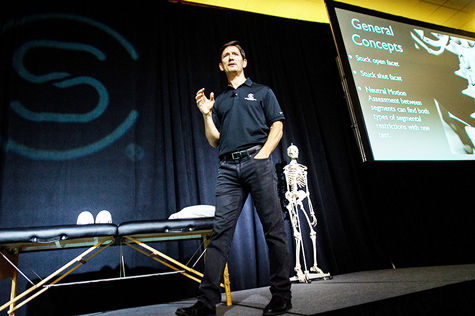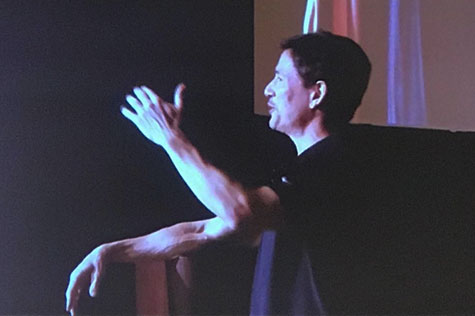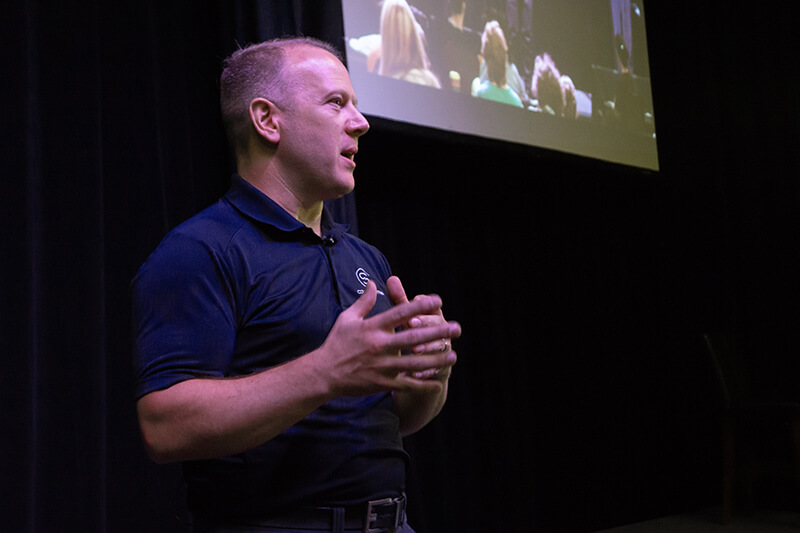FCS Virtual Course Updates
This is a unique opportunity to bring your FCS skills up to speed with one series of courses you can complete from home. Learn game changers like Segmental Motion Testing, new approach to Scar Tissue and complete the prerequisites required for the new Central Sensitization Series.
Day 1
Part 1: Segmental Motion Testing
Prerequisite: 3-Day FCS FI Course Completion
Instructor: Brian Tuckey, PT, OCS, JSCCI

Brian Tuckey, PT, OCS, JSCCI – Originator of Fascial Counterstrain
Brian Tuckey, PT, OCS, JSCCI will present a course on what he calls “reflexive motion testing.” This is a proprietary form of mobility testing, developed over a 30 year period, which allows you to identify in three dimensions, the exact location of all types of neuromuscular dysfunction. Once mastered, this skill gives you an additional, and completely independent test, that will enable you to identify the primary osteopathic lesion. Brian uses this assessment technique on every patient he sees and states that it is one of the primary tools he utilized to develop FCS. Reflexive motion testing is only taught at the CS convention and is a “must have” for any practitioner wishes to reach mastery level.
Additional system updates!
Note that the FCS Scar Tissue approach will be added to
each FCS Update at the 2020 Counterstrain Convention below!
Day 2
FCS MS2 – NEW Techniques
Prerequisite: 3-Day FCS MS2 Course Completion
Instructor: Brian Tuckey, PT, OCS, JSCCI

Brian Tuckey, PT, OCS, JSCCI – Originator of Fascial Counterstrain
Approved: NCBTMB CEU: 9 hours
Overview: Brian has identified over 20 new periosteal techniques since the debut of FCS MS2 2018! These recent, never-been-taught, discoveries address “end-plate dysfunctions” of the long bones which are responsible for everyday conditions such as plantar fasciitis, osteoarthritis of the fingers, hammer toes, tennis elbow, ankle arthritis and inhibited quadriceps muscles. These endplate techniques are NOT clean-up techniques; you will utilize them daily in the clinic. Additionally, the hand foot endplate techniques, like all distal sympathetic branches, have central connections into the autonomic nervous system and are key in the treatment of conditions like CRPS.
Convention FCS MS2 Course Updates: This update course will focus on brand new techniques for upper and lower extremities. Techniques for the long bones of the upper extremity will be taught covering the humerus, radius, ulna, and metacarpals. In addition techniques for the long bones of the lower extremity will be taught including the femur, tibia, fibula, and the metatarsals.
Day 3
FCS Visceral Updates
Prerequisite: 3-Day FCS VC Course Completion
Instructor: Brian Tuckey, PT, OCS, JSCCI
Pending: NCBTMB CEU: 9 hours
Overview: The Visceral system was the first course in the Fascial Series taught by Brian Tuckey, PT, OCS, JSCCI starting with approximately 40 individual techniques. The FCS Visceral course now includes over 80! Powerful new cardiac updates have been added over the last 2 years, including the internal valve structure of the heart (2019), and the pericardium (2018). The newest and most significant update since FCS for the visceral system was released in 2008, is the addition of the techniques applied to the visceral layer known as the mesentery.
Convention FCS VC Course Updates: This update course will include the new mesentery system introduced in 2020 including approximately 26 new techniques that address the mesentery in a segmental fashion from the head to the sacral coccygeal joint. Additional updates include the internal valve structure of the heart & the pericardium. Impact chronic back pain, pelvic pain, breathing restrictions, small and large intestine complaints, irritable bowel syndrome, constipation, food sensitivities, postural issues, loss of spinal ROM, headaches, migraines, upper and lower extremity complaints.
Note: This CSC VC update course fulfills the requirement for the upcoming FCS CSS Series. Please see FCS CSS requirements below for more details.
Day 4
FCS Lymphatic/Venous Updates
Prerequisite: 3-Day FCS LV Course Completion
Instructor: Timothy Hodges, LMT, JSCCI, CACI

Tim Hodges, LMT, JSCCI, CACI director of Counterstrain Academy, LLC
Approved: NCBTMB CEU: 9 hours
Overview: While the first venous treatments were introduced in 2012, it wasn’t until 2016 that the epidural regions were identified and subsequent treatments added to the FCS LV course. In 2017, segmental medullary veins were identified and added to the curriculum. As of April 2019, the deep drainage pathways of the spinal cord were identified and added to the FCS LV curriculum.
Convention FCS LV Course Updates: This update course will target multiple layers of the central nervous system drainage pathways and is designed to provide you with all major updates taught since 2016. You will review 3 different sub-systems within the LV system as a whole – specifically targeting the spinal cord: epidural veins, spinal medullary veins & anterior and posterior spinal cord veins. Impact centrally sensitized patients, reduce centrally mediated muscle spasms, calm CNS tremors, restless legs and reduce or eliminate chronic pain. The latest updates are an absolute game-changer for your most complex patients.
Note: This CSC LV update course fulfills the requirement for the upcoming FCS CSS Series. Please see FCS CSS requirements below for more details.
Day 5
FCS Arterial Updates
Prerequisite: 3-Day FCS AR Course Completion
Instructor: Timothy Hodges, LMT, JSCCI, CACI
Approved: NCBTMB CEU: 9 hours
Overview: FCS Arterial course was introduced in 2012. In 2014, the radicular arteries of the thoracic spine were discovered. No major change to the deep cord arterial supply treatment was added until 2017 when medullary arteries were introduced. In 2019 the deep arterial supply of the spinal cord was added, addressing the very small yet powerful vessels within the spinal cord itself. This is arguably the most significant and powerful update to the arterial system since it debuted in 2012.
 Convention FCS AR Course Updates: This update course will cover the latest techniques including spinal flexion and extension arteries. These techniques address the arteries that supply blood directly into the spinal cord which have been vital in the treatment of chronic pain and complex, failed cases. Learn a collection of techniques including: spinal arteries, medullary arteries, and the segmental arterial system. Help improve sensation, decrease peripheral and idiopathic neuropathies & reduce persistent weakness by increasing the functional capacity of the central nervous system.
Convention FCS AR Course Updates: This update course will cover the latest techniques including spinal flexion and extension arteries. These techniques address the arteries that supply blood directly into the spinal cord which have been vital in the treatment of chronic pain and complex, failed cases. Learn a collection of techniques including: spinal arteries, medullary arteries, and the segmental arterial system. Help improve sensation, decrease peripheral and idiopathic neuropathies & reduce persistent weakness by increasing the functional capacity of the central nervous system.
Note: This CSC AR update course fulfills the requirement for the upcoming FCS CSS Series. Please see FCS CSS requirements below for more details.
| CSS Course | Required* | Recommended* | Convention Equivalent |
|---|---|---|---|
| FCS CSS 1 | FCS LV completed 7/2017 or later | FCS LV & FCS AR 2019 or later, FCS VC 2020 or later | CSC LV, CSC AR, CSC VC |
| FCS CSS 2 | FCS LV completed 7/2017 or later | FCS LV & FCS AR 2019 or later, FCS VC 2020 or later | CSC LV, CSC AR, CSC VC |
| FCS CSS 3 | FCS LV and FCS AR completed 2019 or later | FCS LV & FCS AR 2019 or later, FCS VC 2020 or later | CSC LV, CSC AR, CSC VC |
Day 1
Part 1: Segmental Motion Testing
Prerequisite: 3-Day FCS FI Course Completion
Instructor: Brian Tuckey, PT, OCS, JSCCI

Brian Tuckey, PT, OCS, JSCCI – Originator of Fascial Counterstrain
Brian Tuckey, PT, OCS, JSCCI will present a course on what he calls “reflexive motion testing.” This is a proprietary form of mobility testing, developed over a 30 year period, which allows you to identify in three dimensions, the exact location of all types of neuromuscular dysfunction. Once mastered, this skill gives you an additional, and completely independent test, that will enable you to identify the primary osteopathic lesion. Brian uses this assessment technique on every patient he sees and states that it is one of the primary tools he utilized to develop FCS. Reflexive motion testing is only taught at the CS convention and is a “must have” for any practitioner wishes to reach mastery level.
Day 1
Part 2: Scar Tissue
Prerequisite: 3-Day FCS FI Course Completion
Instructor: Brian Tuckey, PT, OCS, JSCCI
This NEW course is a game-changer; arguably the biggest paradigm shift since the introduction of Fascial Counterstrain! Until recently, the standard approach for Fascial Counterstrain has been based on our understanding of the protective reflexive mechanism. The body’s response to a scar or damaged tissue is pathological and shows up in the scan differently. A lack of understanding in this area holds most practitioners back from long-lasting results because the body will place the protective reflex back in place in response to scarring. This new realization adds another layer of specificity. Now, we have the ability to determine if scar treatment should be prioritized. Don’t miss this important update in the field of Fascial Counterstrain!
Pending: NCBTMB CEU: 5 hours for all of Day 1
Additional system updates!
Note that the FCS Scar Tissue approach will be added to
each FCS Update at the 2020 Counterstrain Convention below!
Day 2
FCS MS2 – NEW Techniques
Prerequisite: 3-Day FCS MS2 Course Completion
Instructor: Brian Tuckey, PT, OCS, JSCCI

Brian Tuckey, PT, OCS, JSCCI – Originator of Fascial Counterstrain
Pending: NCBTMB CEU: 9 hours
Overview: Brian has identified over 20 new periosteal techniques since the debut of FCS MS2 2018! These recent, never-been-taught, discoveries address “end-plate dysfunctions” of the long bones which are responsible for everyday conditions such as plantar fasciitis, osteoarthritis of the fingers, hammer toes, tennis elbow, ankle arthritis and inhibited quadriceps muscles. These endplate techniques are NOT clean-up techniques; you will utilize them daily in the clinic. Additionally, the hand foot endplate techniques, like all distal sympathetic branches, have central connections into the autonomic nervous system and are key in the treatment of conditions like CRPS.
Convention FCS MS2 Course Updates: This update course will focus on brand new techniques for upper and lower extremities. Techniques for the long bones of the upper extremity will be taught covering the humerus, radius, ulna, and metacarpals. In addition techniques for the long bones of the lower extremity will be taught including the femur, tibia, fibula, and the metatarsals.
Day 3
FCS Visceral Updates
Prerequisite: 3-Day FCS VC Course Completion
Instructor: Brian Tuckey, PT, OCS, JSCCI
Pending: NCBTMB CEU: 9 hours
Overview: The Visceral system was the first course in the Fascial Series taught by Brian Tuckey, PT, OCS, JSCCI starting with approximately 40 individual techniques. The FCS Visceral course now includes over 80! Powerful new cardiac updates have been added over the last 2 years, including the internal valve structure of the heart (2019), and the pericardium (2018). The newest and most significant update since FCS for the visceral system was released in 2008, is the addition of the techniques applied to the visceral layer known as the mesentery.
Convention FCS VC Course Updates: This update course will include the new mesentery system introduced in 2020 including approximately 26 new techniques that address the mesentery in a segmental fashion from the head to the sacral coccygeal joint. Additional updates include the internal valve structure of the heart & the pericardium. Impact chronic back pain, pelvic pain, breathing restrictions, small and large intestine complaints, irritable bowel syndrome, constipation, food sensitivities, postural issues, loss of spinal ROM, headaches, migraines, upper and lower extremity complaints.
Note: This CSC VC update course fulfills the requirement for the upcoming FCS CSS Series. Please see FCS CSS requirements below for more details.
Day 4
FCS Lymphatic/Venous Updates
Prerequisite: 3-Day FCS LV Course Completion
Instructor: Timothy Hodges, LMT, JSCCI, CACI

Tim Hodges, LMT, JSCCI, CACI director of Counterstrain Academy, LLC
Pending: NCBTMB CEU: 9 hours
Overview: While the first venous treatments were introduced in 2012, it wasn’t until 2016 that the epidural regions were identified and subsequent treatments added to the FCS LV course. In 2017, segmental medullary veins were identified and added to the curriculum. As of April 2019, the deep drainage pathways of the spinal cord were identified and added to the FCS LV curriculum.
Convention FCS LV Course Updates: This update course will target multiple layers of the central nervous system drainage pathways and is designed to provide you with all major updates taught since 2016. You will review 3 different sub-systems within the LV system as a whole – specifically targeting the spinal cord: epidural veins, spinal medullary veins & anterior and posterior spinal cord veins. Impact centrally sensitized patients, reduce centrally mediated muscle spasms, calm CNS tremors, restless legs and reduce or eliminate chronic pain. The latest updates are an absolute game-changer for your most complex patients.
Note: This CSC LV update course fulfills the requirement for the upcoming FCS CSS Series. Please see FCS CSS requirements below for more details.
Day 5
FCS Arterial Updates
Prerequisite: 3-Day FCS AR Course Completion
Instructor: Timothy Hodges, LMT, JSCCI, CACI
Pending: NCBTMB CEU: 9 hours
Overview: FCS Arterial course was introduced in 2012. In 2014, the radicular arteries of the thoracic spine were discovered. No major change to the deep cord arterial supply treatment was added until 2017 when medullary arteries were introduced. In 2019 the deep arterial supply of the spinal cord was added, addressing the very small yet powerful vessels within the spinal cord itself. This is arguably the most significant and powerful update to the arterial system since it debuted in 2012.
 Convention FCS AR Course Updates: This update course will cover the latest techniques including spinal flexion and extension arteries. These techniques address the arteries that supply blood directly into the spinal cord which have been vital in the treatment of chronic pain and complex, failed cases. Learn a collection of techniques including: spinal arteries, medullary arteries, and the segmental arterial system. Help improve sensation, decrease peripheral and idiopathic neuropathies & reduce persistent weakness by increasing the functional capacity of the central nervous system.
Convention FCS AR Course Updates: This update course will cover the latest techniques including spinal flexion and extension arteries. These techniques address the arteries that supply blood directly into the spinal cord which have been vital in the treatment of chronic pain and complex, failed cases. Learn a collection of techniques including: spinal arteries, medullary arteries, and the segmental arterial system. Help improve sensation, decrease peripheral and idiopathic neuropathies & reduce persistent weakness by increasing the functional capacity of the central nervous system.
Note: This CSC AR update course fulfills the requirement for the upcoming FCS CSS Series. Please see FCS CSS requirements below for more details.
CS Convention Course Prerequisites
| Convention Course | Prerequisite |
|---|---|
| CSC Mod 1 Intro | 3-Day FCS-FI Intro |
| Segmental Motion Testing | 3-Day FCS-FI Intro |
| Lymphatic/Venous Updates | 3-Day FCS LV |
| Arterial Updates | 3-Day FCS AR |
| Visceral Updates | 3-Day FCS VC |
| MS2 Updates | 3-Day FCS MS2 |
| Scar Tissue | 3-Day FCS-FI Intro |
Would you like more information on the entire Fascial Counterstrain training curriculum and prerequisites? Check out our Fascial Counterstrain Training section for more details.